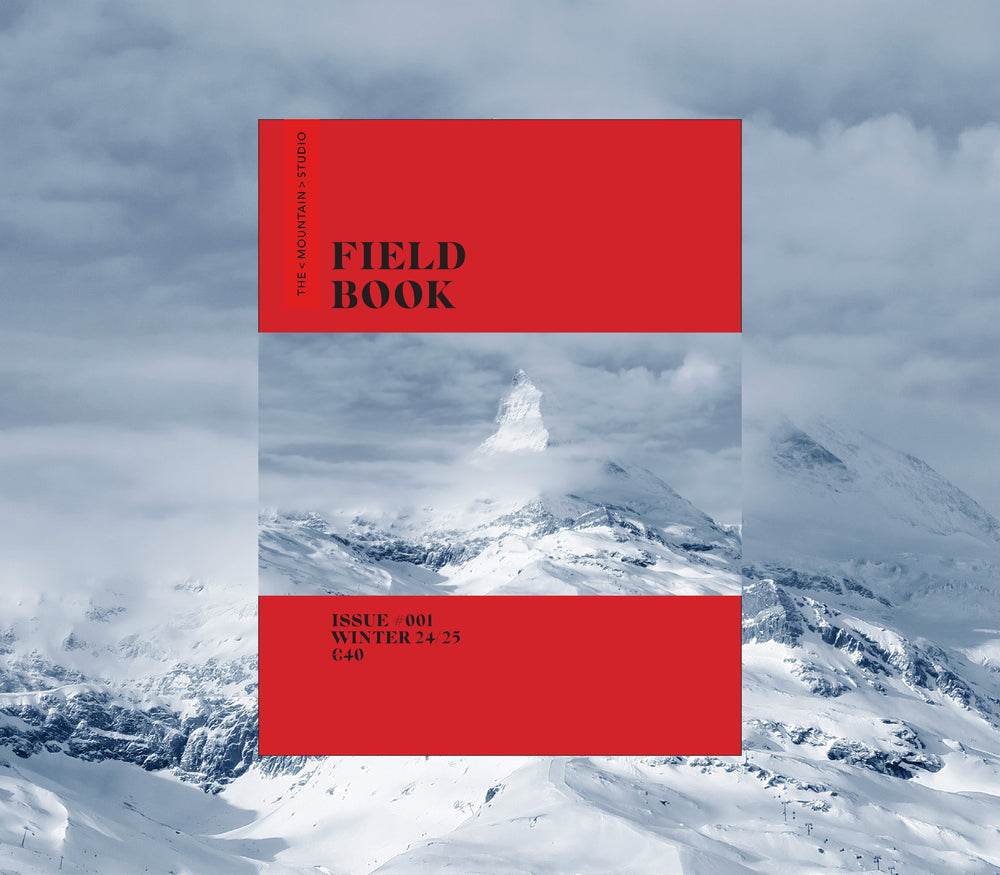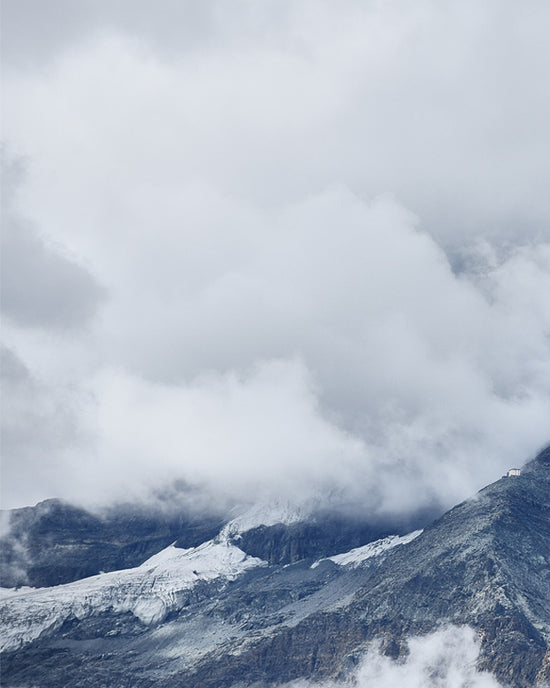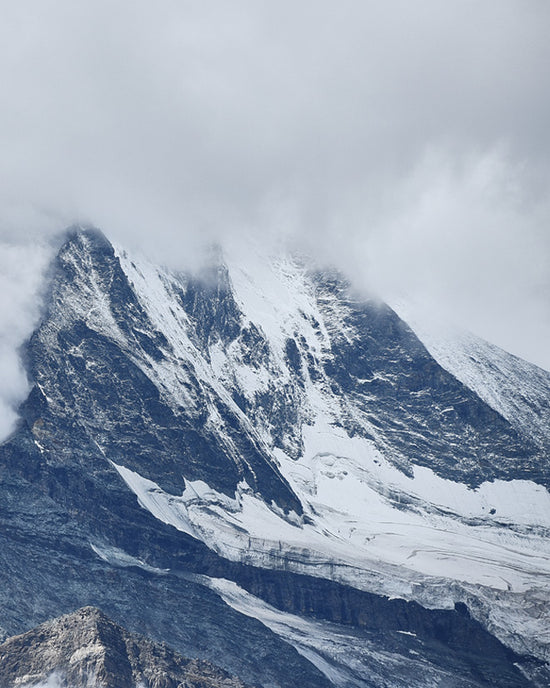
The Road
to Matterhorn
Life truly begins at the end of the road, where the only way is up and a gigantic monolith, the Matterhorn, towers over one and all.
(Feature story from the Field Book Issue 1)
Mountains do something to us humans. Their sheer existence triggers a range of emotions: wonder at their size and their beauty, a lust for exploration, fear, inspiration, hope, joy, and countless others. Mountains visit our most beautiful dreams and haunt our worst nightmares, making us feel small and big all at once. This complex array of reactions helps explain why it is that mountains seem to bring out both the very best and the very worst in us.
However, more than anything, mountains elevate our sense of life. No human being can stand at the foot of a massive mountain and honestly claim that looking up at the peak in the sky leaves them completely unmoved.
This is no more true of any mountain than the one that towers over the Mattertal valley and the small town of Zermatt. Because there are mountains, and then there’s the Matterhorn.

While it is by no means the tallest mountain on planet Earth, nor the hardest to climb or the best to ski down, this near-perfect pyramid of gneiss has no rival when it comes to drama and geometric beauty. The first time you see the Matterhorn, your eyes are immediately drawn to its majestic presence. You’ll find yourself almost transfixed in amazement at this wonder of nature, which was created by geological happenstance when several glaciers withdrew from the peak and the erosion carved out an almost perfect, pyramidal shape, a glacial horn.
For some, just looking at a mountain isn’t enough. Sometimes, the urge to conquer it and set foot on the summit can grow into an life-consuming obsession. When the great George Mallory was asked why he wanted to climb Mount Everest, he simply replied “because it’s there”.
Apart from the very tallest peaks on the planet, no other mountain has drawn the kind of attention from climbers that the Matterhorn attracts. With its perfect shape, knife-sharp ridges, needle-like summit, and dominating presence in the valley, it just begs to be climbed. Because it’s there.


Naturally, the Matterhorn was an irresistible climbing challenge during the golden age of alpinism in the mid-1800s, when the grand peaks of the Alps were conquered one by one. Many alpinists tried, and failed, many of them in tragic ways, until a team led by the brit Edward Whymper reached the peak on 14 July 1865.
The seven-member group made their ascent via the shoulder on the Hörnligrat, and switched over to the north wall further up. Edward Whymper was the first to reach the peak. He was followed by the mountain guide Michel Croz from Chamonix, and the Reverend Charles Hudson, Lord Francis Douglas, and Douglas Robert Hadow, all from England, as well as a local mountain guide, Peter Taugwalder, and his son of the same name.
The expedition was struck by tragedy, though, when four members of the team were killed in an accident during the descent. The front rope team, which consisted of Croz, Hadow, Hudson, and Douglas, all fell to their deaths over the north wall while still above the Hörnligrat shoulder. Three of the bodies were recovered a few days later on the Matterhorn glacier. Lord Francis Douglas, however, has still not been found to this day.
As the Matterhorn was the last of the great alpine peaks to be conquered, this event marked the end of an era. However, after the first ascent, the feat still asked to be repeated, over and over again, and an increasing number of attempts were made to climb the other peaks in the valley, too. The Matterhorn, you see, is surrounded by some of the highest peaks of the Alps, including numerous four-thousanders. In fact, the village is within close proximity of six of the ten highest peaks of the Alps.
Since then, people from all over the world have been drawn to this small mountain town in western Switzerland. Skiers, guides, climbers, mountain bikers, artists, painters, photographers, writers, storytellers, musicians, and dreamers alike flock to Zermatt to tell their own stories and paint their own pictures. It’s an eclectic, powerful, and diverse mix of people, who have transformed what was once a farming village at the end of the road into a cosmopolitan melting pot for passionate mountain people from all over the world.


That end of the road is the place where the “real” world ends, and real life begins. This is where you leave the ordinary world behind, and enter a world of adventure and exploration. Here, your imagination is free to decide how you will move forward. Or upward, for that matter.
It is this freedom of the imagination that has attracted the Whympers of the world to the unknown and filled them with the urge to conquer and explore it. This is what has brought generations of Average Joes to push themselves just a little bit further beyond their own limits.
The mountains at the end of the road turn dreams into reality, thoughts into expression, and inspiration into art. They give life, and, frankly, end lives as well.
Most importantly, though, they give real meaning to the time we have. They fill us with emotions, with fear, with joy, with tears, and with laughter. They fill us with dreams of something bigger than ourselves. Mountains elevate our feelings and widen our senses to a point where we may no longer be able to resist their allure.

Because time, however simple the concept might seem at first glance, is never something that can fully be quantified. A few seconds of pure elation can mean more, and be far more memorable, than several years’ worth of the plod of everyday life. Life, after all, is full of little moments, all linked together on a timeline and leading to an abrupt, dark end. In the human experience, most of those moments just pass by, without leaving much of a mark, if any. They’re just units of time.
Certain moments though, stand apart from the rest, whether they involve approaching the boundaries of human endeavour and our own personal limits, or some quiet contemplation of the sheer beauty of the mountains in front of our eyes. These moments stand out like peaks on the timeline of existence, they’re points in time that are etched into our memory, never to be erased. Without them, life would be no more than an act of existing.

Since the dawn of time, mountains have had a way of turning moments into memories that has tempted human beings to give up everything for a chance to stand at their peaks. It’s been said that climbing a mountain is the hardest way of returning to where you started. Now, that’s undeniably true, provided you do make it back safely. But it’s the journey there, and back, that gives rise to the stories that will be shared forever. For some, the journey can last a lifetime, and there are few other places on this planet of ours that serve up the temptation of greatness quite like the dramatic Mattertal.
Quietly, the mighty Matterhorn sits at the far end of the valley, towering overhead. Holding on to its secrets and luring you in with its presence. Telling you to come closer, and to never leave.








